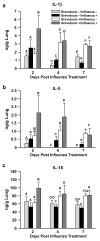Brevetoxin inhalation alters the pulmonary response to influenza A in the male F344 rat
- PMID: 21240731
- PMCID: PMC3444170
- DOI: 10.1080/15287394.2010.519316
Brevetoxin inhalation alters the pulmonary response to influenza A in the male F344 rat
Abstract
Epidemiological studies demonstrated that the number of emergency-room visits for respiratory indications increases during periods of Florida Red Tides. The purpose of this study was to examine whether or not repeated brevetoxin inhalation, as may occur during a Florida Red Tide, affects pulmonary responses to influenza A. Male F344 rats were divided into four groups: (1) sham aerosol/no influenza; (2) sham aerosol/influenza; (3) brevetoxin/no influenza; and (4) brevetoxin/influenza. Animals were exposed by nose-only inhalation to vehicle or 50 μg brevetoxin-3/m3, 2 h/d for 12 d. On d 6 of aerosol exposure, groups 2 and 4 were administered 10,000 plaque-forming units of influenza A, strain HKX-31 (H3N2), by intratracheal instillation. Subgroups were euthanized at 2, 4, and 7 d post influenza treatment. Lungs were evaluated for viral load, cytokine content, and histopathologic changes. Influenza virus was cleared from the lungs over the 7-d period; however, there was significantly more virus remaining in the group 4 lungs compared to group 2. Influenza virus significantly increased interleukins-1α and -6 and monocyte chemotactic protein-1 in lung; brevetoxin exposure significantly enhanced the influenza-induced response. At 7 d, the severity of perivascular and peribronchiolar inflammatory cell infiltrates was greatest in group 4. Bronchiolitis persisted, with low incidence and severity, only in group 4 at d 7. These results suggest that repeated inhalation exposure to brevetoxin may delay virus particle clearance and recovery from influenza A infection in the rat lung.
Figures





References
-
- Ada GL, Jones PD. The immune response to influenza infection. Curr Top Microbiol Immunol. 1986;128:1–54. - PubMed
-
- Backer LC, Fleming LE, Rowan A, Cheng YS, Benson J, Pierce RH, Zaias J, Bean J, Bossart GD, Johnson D. Recreational exposure to aerosolized brevetoxins during Florida Red Tide events. Harmful Algae. 2003;2:19–28. - PubMed
-
- Backer LC, Kirkpatrick B, Fleming LE, Cheng YS, Pierce R, Bean JA, Clark R, Johnson D, Wanner A, Tamer R, Zhou Y, Baden D. Occupational exposure to aerosolized brevetoxins during Florida Red Tide events: Effects on a healthy worker population. Environ Health Perspect. 2005;113:644–649. - PMC - PubMed
-
- Baden DG, Mende JJ, Lichter W, Wellham L. Crystallization and toxicology of T34: A major toxin from Florida’s Red Tide organism (Ptychodiscus brevis) Toxicon. 1981;19:455–462. - PubMed
-
- Benson JM, Hahn FF, Tibbetts BM, Bowen LE, March TH, Langley RJ, Murray TF, Bourdelais AJ, Naar J, Zaias J, Baden DG. Florida Red Tide: Inhalation toxicity of Karenia breve extract in rats. In: Steidinger KA, Landsberg JH, Tomas CR, Vargo GA, editors. Harmful Algae 2002, Proceedings of the Xth International Conference on Harmful Algae. Florida Fish and Wildlife Conservation Commission, Florida Institute of Oceanography, and Intergovernmental Oceanographic Commission of UNESCO; 2004a. pp. 502–504. - PMC - PubMed
Publication types
MeSH terms
Substances
Grants and funding
LinkOut - more resources
Full Text Sources
Research Materials
